Jean-Honoré Fragonard Biography
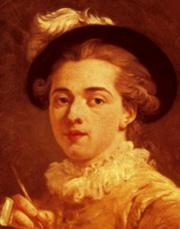
Jean-Honoré Fragonard (called “the Amiable Frago” by his friends) was born on April 5, 1732 into a solidly middle-class family. They resided in the city of Grasse in the hills of southeastern France, not far from the Mediterranean. His father, François Fragonard, was a glove manufacturer. Somewhere around this time he invested heavily into a business plan to supply Paris with its first fire pump, in which he lost his money. In an attempt to recover it, he moved with his family to the capital, where the matter ended in a ruinous lawsuit. Honoré was about six at this time.
The family had rather standard ambitions for their only child, and by his mid-teens they obtained for Honoré a desirable clerkship with a notary, an official status in France. Unfortunately, this career soon came to an end when his employer fired the young clerk on the grounds that he did nothing but draw pictures.
Taking the complaints of their son’s ex-employer to heart, Fragonard’s mother, Françoise Fragonard, enlisted him as a pupil in the one of the leading ateliers in Paris, the studio of François Boucher, who was then Royal Painter of the French king and held an appointment as one of the twelve professors at the Royal Academy. However, Boucher turned down the Fragonards, saying that he only took students who already knew how to paint. Instead he directed them to Jean-Baptiste Siméon Chardin, a painter specializing in the still life genre.
Although Chardin did take on Honoré, the two were ill matched in temperament, Chardin’s methods seeming too slow and meticulous for the hasty Fragonard, who was described by his own grandson as having “too much imagination to limit himself to painting portraits of vegetables”. Honoré’s arrangement with Chardin ended on a similar note to his job with the notary, but the inclusion of still lifes in some of Fragonard’s later paintings and the manner in which they were painted indicate that he had not come away from Chardin’s lessons empty-handed. Nevertheless, this break was another disappointment for the Fragonards.
Honoré went once more to Boucher and presented him with a handful of paintings he had drawn in his free time. Impressed, Boucher not only accepted the young artist, but even refused to charge tuition, realizing that he would be able to exploit Fragonard's talent to good profit.
Fragonard turned out to be an exceptional student and learned quickly. Only four years into his apprenticeship, Boucher prompted him to enter the contest for the highly desirable Prix de Rome, whose winner was awarded a scholarship for three years at the Académie de France in Rome. Honoré not only entered the contest, but managed to take first place with his Jereboam Sacrificing to the Idols (1752), immediately gaining recognition across Paris.
In May 1753 Fragonard moved to the royal school for first-prize winners. The Ecole Royale des Élèves Protégés had been founded four years prior with the purpose of preparing contest winners for their education in Rome. The school was under the personal patronage of the king and thus its students received full scholarships. The idea behind segregating talented art students was that they would be tutored to become historical painters (which was then considered the noblest calling for an artist) and would then become available for service to the crown.
During his stay at the Ecole, Fragonard painted Psyche Shows Her Sisters the Presents She Has Received from Cupid (1753-54), which was exhibited at Versailles the following January. In the same year he was commissioned a painting for the chapel of the Confraternity of the Blessed Sacrament at Grasse. The final result of the artist’s efforts was Christ Washing the Feet of the Apostles (1754-55), which can still be seen in the Grasse Cathedral today.
In 1756 Fragonard left for Rome to start his education at the Académie de France, arriving just before Christmas. His initial three-year stay stretched to four years.
Fragonard’s performance at the Académie could only be described as sub par. According to some sources, he described himself as having been overwhelmed by the works of Raphael and Michelangelo to the point of discouragement. He also didn’t take well to the long-established practice of drawing from casts and classical statues, preferring the freedom and exuberance of the great Baroque painters, and although the director of the school permitted him to go his own way, it was not until 1760, when under the patronage of the Abbé de Saint-Non, that Fragonard began to realize his own talents. The Abbé was a wealthy amateur artist who had come to Rome to study Italian culture. Upon meeting Fragonard he was apparently impressed with the other’s artistic abilities and invited the young artist to accompany him to Venice, at his expense. Afterwards Fragonard traveled alone to Naples, copying the works of many Baroque masters in pen and ink sketches, which were later published through Saint-Non.
In 1761 Fragonard and Saint-Non arrived in Paris, where Fragonard worked in relative obscurity, fleshing out some of his sketches into complete compositions, such as The Gardens of the Villa d’Este (1762). His first big success came in 1765 with the painting Coresus Sacrificing Himself to Save Callirhoe (1765), which was exhibited at the Salon and granted Fragonard membership in the Academy. However, it was at this point that Fragonard abandoned historical painting altogether and instead decided to pursue the significantly more lucrative genre of erotic art, in which he had already established a reputation.
In 1766 Fragonard was commissioned to paint the now-famous canvas The Swing (1766-67). After this he received a steady stream of commissions for erotic or sensual paintings from various wealthy patrons throughout Paris. In 1767 Fragonard exhibited at the Salon again, where his erotic scenes understandably came under fire from critics, marking this as his last appearance at the Salon. Undeterred, he continued to paint erotic commissions, as well as a series of portraits of his friends and patrons in fancy dresses, such as The Actor (1769).
Three years later Fragonard married Marie-Anne Gérard, the elder daughter of a perfumer from Grasse, who had originally come to Fragonard for instruction in painting. Although the marriage was a fairly happy one, Marie-Anne was a homely woman, and Fragonard later showed a marked interest in her significantly more charming younger sister, Marguerite Gérard, who came to live with the Fragonards in 1775 to take painting lessons.
In 1771 Fragonard was commissioned by Madame du Barry, King Louis XV's mistress to paint four panels for a new garden pavilion at her château de Louveciennes. The result was the Progress of Love series (1770-1772), which was later returned to the painter in 1773 and replaced with a set of panels in the new semi-classical style. Fragonard was deeply hurt by this turn of events, refusing the payment offered with the paintings’ return.
Later that year Fragonard went on a second trip to Italy, this time at the expense of Bergeret de Grancourt, a wealthy financier, who would soon become an important patron. Upon his return, Fragonard used his refreshed memories of the Italian landscape to paint a series of canvases, including The Swing (1775) and Blind Man’s Bluff (1775). During this period he also painted a number of domestic scenes and portraits of women, including A Young Girl Reading (1775) and The Love Letter (1775).
By 1780 Fragonard’s career had passed its peak. Erotic paintings and the exuberant decorative style he was known for had gradually begun to go out of fashion, replaced by Neo-Classicism, which would gain more popularity in the years leading up to the French Revolution. When the Revolution did occur in 1789, Fragonard and his family were not affected in any significant way, although they did flee to Grasse during the Terror. They returned in 1791, and a year later Fragonard’s son entered the studio of arguably the most influential painters in France, Jacques-Louis David. It was thanks to him that Fragonard gained an administrative post in the newly formed Museums Commission in 1793. The post granted him free accommodation at the Louvre and a steady income which allowed him to live in comfort for the next handful of years.
By 1799, however, he was ousted from both the Commission and the Louvre, when Napoleon decided to turn it into a museum. The Fragonards took lodgings with Margeurite Gérard in the Palais Royale. Fragonard died seven years later on 22 August 1806.
Bibliography
Fragonard. Biographical and Critical Study by Jacques Thuillier. 1967. Geneva.
Fragonard's Allegories of Love by Andrei Molotiu. Getty Publications, 2008.
Fragonard by Pierre Rosenberg. Harry N Abrams, 1988.
Fragonard's Playful Paintings: Visual Games in Rococo Art by Jennifer Milam. Manchester University Press, 2007.
Jean-Honore Fragonard: Life and Work: Complete Catalogue of the Oil Paintings by Jean-Pierre Cuzin. Harry N Abrams, 1988.
The Age of Watteau, Chardin, and Fragonard: Masterpieces of French Genre Painting by Colin B. Bailey, Philip Conisbee, Thomas W. Gaehtgens. Yale University Press, 2003.
- Jeroboam Sacrificing To The Idols.
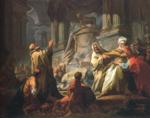
1752. Oil on canvas. Ecole nationale supérieure des Beaux-Arts, Paris, France. Read Note.
- Psyche Showing Her Sisters Her Gifts From Cupid.
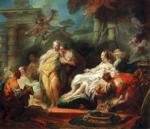
1753-54. Oil on canvas. 168 x 192 cm. National Gallery, London, UK. Read Note.
- The Gardens Of The Villa D 'Este At Tivoli ("The Little Park").
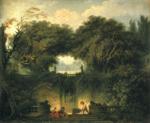
c.1761-62. Oil on canvas. Wallace Collection, London, UK.
- The High Priest Coresus Sacrifices Himself To Save Callirhoe.
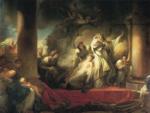
Oil on canvas. 309 x 400 cm. Louvre, Paris, France. Read Note.
- The Swing.
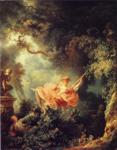
1767. Oil on canvas. 83 x 66 cm. Wallace Collection, London, UK.
- Portrait Of A Young Man ("The Actor").
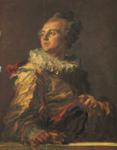
c.1769. Oil on canvas. 80 x 65 cm. Private collection.
- The Pursuit. One Of The Panels From The Progress Of Love.
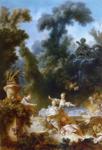
1771-72. Oil on canvas. The Frick Collection, New York, USA.
- A Young Girl Reading.
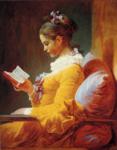
c.1776. Oil on canvas. 81 x 65 cm. The National Gallery of Art, Washington, DC, USA.
- The Love Letter.
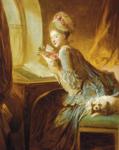
1770s. Oil on canvas. 83.2 x 67 cm. The Metropolitan Museum of Art, New York, USA.